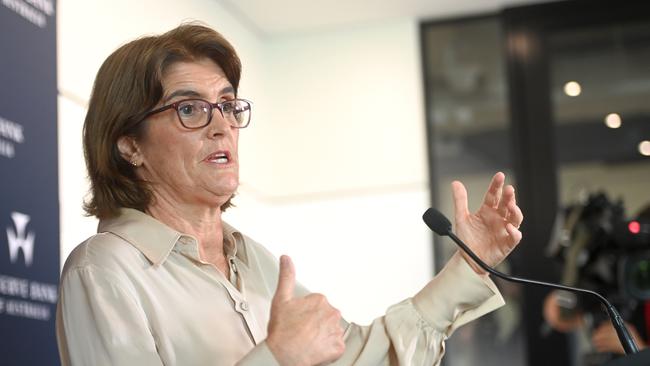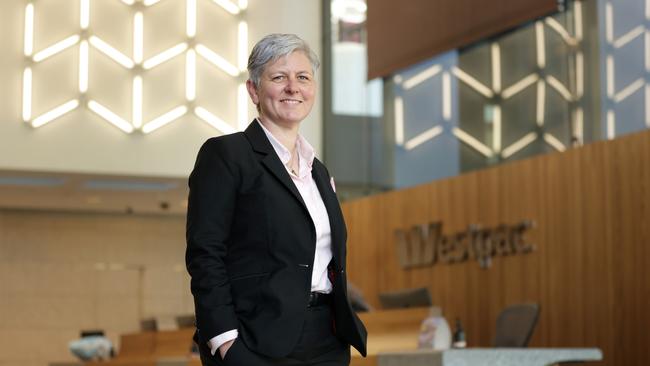The RBA softens is interest rates guidance but the war against inflation isn’t won yet
The Reserve Bank has moderated its language about the outlook for interest rates after a rise in the unemployment rate.

The Reserve Bank has responded to signs of weakness in the jobs market by softening its language on the outlook for interest rates, while warning that the “war isn’t yet won” on inflation.
In an earlier-than-expected shift to a neutral policy outlook in its post-meeting decision statement on Tuesday, the central bank said it was “not ruling anything in or out” on interest rates.
It came as the board announced a widely expected decision to leave the cash rate at a 12-year high of 4.35 per cent, after delivering a rapid increase from a record low of 10 basis points in May 2022 to crack down on a damaging outbreak of inflation in the wake of the Covid-19 pandemic.
RBA governor Michele Bullock took the same equivocal line on the interest rate outlook as in her press conference last month.
It also appeared in the minutes of the February board meeting, along with a version of that month’s hawkish decision statement guidance that “a further increase in interest rates cannot be ruled out”.
But the shift to a purely balanced outlook for interest rates in the post-meeting decision statement on Tuesday had a dovish impact on Australian financial markets.
The Australian dollar fell 0.6 per cent to a two-week low of US65.14c, the policy-sensitive three-year bond yield fell 6 basis points to 3.67 per cent, and the S&P/ASX 200 share index rose 0.4 per cent to 7703, helped by a rebound in iron ore prices after a sharp fall in recent weeks.


The Australian dollar’s fall was magnified by a rise in the US dollar as the Japanese yen fell after a widely expected decision by the Bank of Japan to lift interest rates for the first time in 17 years.
In her post-meeting press conference on Tuesday, the RBA governor explained that the “cautious” wording of the decision statement was due to recent weakness in the labour market.
“We understand that households are still bearing the brunt of this inflation challenge,” she said.
“We see that in the weak consumption data, and we know that there is a big cost of living squeeze on households.
“Unemployment’s also ticked up a bit.
“Employment’s continuing to grow, but these are firmly on the board’s radar and that’s why we’re being cautious.”
NAB head of market economics Tapas Strickland said: “The change to the prior soft tightening bias in the post-meeting statement was a conscious decision in response to the data flow. The RBA is clearly very sensitive to labour market developments.” The unemployment rate has risen from 3.6 to 4.1 per cent since September. If sustained for a few months, it could signal to some economists that a recession has already begun, based on the so-called Sahm Rule.
Australia’s latest official employment figures for February are due for release on Thursday.
Ms Bullock noted some softening in demand in discretionary sectors in the RBA’s business liaison program, but said the message from liaison was broadly in line with the hard data. Mr Strickland said: “That overall suggests the board is firmly in a wait and see mode, but without an explicit bias to hike.
“We didn’t put much stock in the RBA’s soft tightening bias in February, so don’t think this has large implications for the outlook.”
NAB expects a first cut in November.
The RBA board and governor sounded equally worried about inflation.
“We still have to get inflation down and the risks to achieving that remain finely balanced,” Ms Bullock said in her press conference.
“The war isn’t yet won. So we continue to be vigilant and we can’t rule anything in or out.”
CBA head of Australian economics Gareth Aird said the Reserve Bank had ended its bias towards higher interest rates earlier than expected, after it started hiking rates in May 2022.
“The removal of the hiking bias means the RBA board is now more confident they will not need to raise the cash rate again compared with a month ago,” he said.
“The weak December quarter economic growth coupled with the January monthly CPI indicator and recent labour market data would have fed into the decision to make the shift to a neutral bias.”
RBA board’s post-meeting decision statement made reference to the January monthly CPI indicator, noting that “the headline monthly CPI indicator was steady at 3.4 per cent over the year to January, with momentum easing over recent months”.
The statement once again emphasised the ‘‘highly uncertain outlook’’.
Seven references were made to ‘‘uncertainty’’ in the statement compared to five the previous month.

“The board clearly wants to communicate that there are a lot of moving parts to the economic picture presently and the board wants full optionality to shift their policy position quickly if the data makes the case,” Mr Aird said.
With no meeting scheduled in April the RBA board will gauge two employment reports ahead of the May meeting, as well as the March quarter inflation report.
Mr Aird said that if the trimmed mean CPI comes in below his forecast of 0.8 per cent, quarter on quarter, the RBA could shift to an easing bias as soon as May.
CBA expects the RBA to start cutting rates in September and to lower the cash rate from its current 3.35 per cent to 2.85 per cent by mid-2025, barring a further large increase in wages.
“We believe the risk now sits with August for the commencement of an easing cycle, provided the Fair Work Commission hands down a lift in the minimum and award wage of no more than 4.25 per cent,” he said.
CBA expects the RBA to start an easing cycle in September 2024.
But Mr Aird said that after Tuesday’s statement, rate cuts could start in August if wage rises are moderate.
Westpac chief economist Luci Ellis – until recently assistant governor at the RBA – said there was another important deletion from the post-meeting statement: that it would “do what is necessary to achieve that outcome” (returning inflation to target).
“The implication here is that the board no longer needs to commit to doing what is needed, because no additional action is needed to achieve the desired outcome,” Ms Ellis said.
“With these deletions, what remains in the media release are the words of a central bank that is on hold, but not quite willing to say so outright.”
Westpac expects rate cuts from September.




To join the conversation, please log in. Don't have an account? Register
Join the conversation, you are commenting as Logout